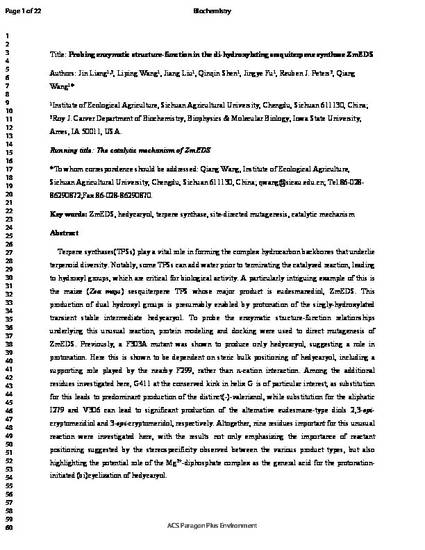
Terpene synthases(TPSs) play a vital role in forming the complex hydrocarbon backbones that underlie terpenoid diversity. Notably, some TPSs can add water prior to terminating the catalyzed reaction, leading to hydroxyl groups, which are critical for biological activity. A particularly intriguing example of this is the maize (Zea mays) sesquiterpene TPS whose major product is eudesmanediol, ZmEDS. This production of dual hydroxyl groups is presumably enabled by protonation of the singly-hydroxylated transient stable intermediate hedycaryol. To probe the enzymatic structure-function relationships underlying this unusual reaction, protein modeling and docking were used to direct mutagenesis of ZmEDS. Previously, a F303A mutant was shown to produce only hedycaryol, suggesting a role in protonation. Here this is shown to be dependent on steric bulk positioning of hedycaryol, including a supporting role played by the nearby F299, rather than π-cation interaction. Among the additional residues investigated here, G411 at the conserved kink in helix G is of particular interest, as substitution for this leads to predominant production of the distinct(-)-valerianol, while substitution for the aliphatic I279 and V306 can lead to significant production of the alternative eudesmane-type diols 2,3-epi- cryptomeridiol and 3-epi-cryptomeridol, respectively. Altogether, nine residues important for this unusual reaction were investigated here, with the results not only emphasizing the importance of reactant positioning suggested by the stereospecificity observed between the various product types, but also highlighting the potential role of the Mg2+-diphosphate complex as the general acid for the protonation- initiated (bi)cyclization of hedycaryol.
Available at: http://works.bepress.com/reuben_peters/106/

This is a manuscript of an article published as Liang, Jin, Liping Wang, Jiang Liu, Qinqin Shen, Jingye Fu, Reuben J. Peters, and Qiang Wang. "Probing enzymatic structure-function in the di-hydroxylating sesquiterpene synthase ZmEDS." Biochemistry (2020). doi: 10.1021/acs.biochem.0c00395. Posted with permission.